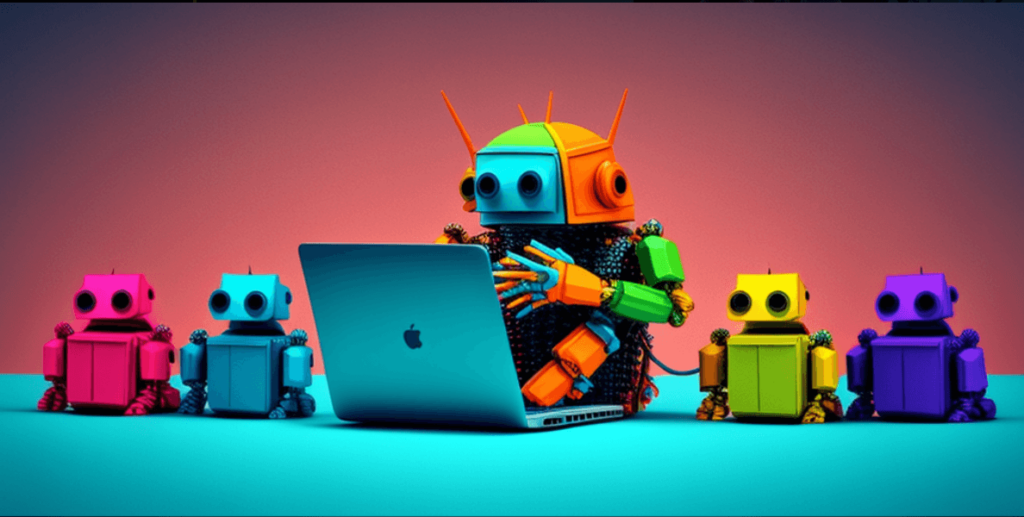The largest supercomputer in the world for AI training has just been unveiled today – and it is phenomenal. But, here’s the kicker: there are eight more on the way. By next year, we will be looking at an interconnected galaxy of supercomputers that promises to revolutionize the AI landscape!
In simpler words, this is like transforming AI training from a leisurely walk to your destination – to now using a supersonic jet flight in terms of speed and efficiency.
Has the era of Artificial general intelligence (AGI) truly begun? Here’s what you should know (and do):
Largest AI Supercomputer – Condor Galaxy 1 (CG-1)
AI trailblazer, Cerebras Systems, and UAE-based AI technology holding group, G42, have teamed up to create Condor Galaxy 1 (CG-1), a 4 exaFLOP, 54 million core, cloud-based AI supercomputer (with 8 more equivalent spec computers on the way).
An exaFLOP is a unit of computing speed. If you imagine a single FLOP as one calculation, an exaFLOP represents a quintillion (that’s a billion billion) calculations per second! (Supercomputers are 100 million to 1 billion times faster than a normal desktop computer, in case you wondering).
A core is like an individual worker in a computer. The more cores you have, the more tasks your computer can handle at the same time. So, if a computer has 54 million cores, it’s like having 54 million little workers inside your computer all doing different tasks simultaneously.
CG-1, is already up and running and housed in Santa Clara, California. It has 64 Cerebras CS-2 systems hooked up to it
And, it’s available as a cloud service. That means anyone (with a bit of money) can tap into its power without having to own or manage any physical systems.
And, based on the data we can find here, at current specs, CG-1 is already the largest Supercomputer available – even without its siblings connected to it.
How does CG-1 compare with the other supercomputers of the world?

| Supercomputer | ExaFLOP | Cores |
|---|---|---|
| CG-1 | 4 | 54,000,000 |
| Frontier | 1.1 | 1,300,000 |
| Fugaku | 415.5 petaFLOPs | 7,630,808 |
| LUMI | 151.9 petaFLOPs | 196,608 |
| Perlmutter | 62.8 petaFLOPs | 6,400 |
| RSC | 60.4 petaFLOPs | 176,400 |
Fun Fact: The supercomputer with the largest cores in the world is Cerebras CS-2, which has a total of 1.2 trillion cores. But, it “only” has 0.4 exaFLOPs, and usually runs at 0.18.
CG-1 under the hood – for the techies

CG-1 is a beast of a machine that’s specifically designed for large language models and generative AI. With a whopping 4 exaFLOPs of 16-bit AI compute power, it can handle up to 600 billion parameter models as standard. And, it can extend its configurations to support models with up to 100 trillion parameters!
Under the hood, CG-1 is powered by 54 million AI-optimized compute cores, 388 terabits of fabric bandwidth, and an impressive 72,704 AMD EPYC processor cores. And unlike any known GPU cluster, CG-1 boasts almost perfect performance scaling from 1 to 64 CS-2 systems using simple data parallelism.
But what about training with long sequence lengths? CG-1 can handle sequence lengths up to 50,000 tokens right out of the box, no special software libraries needed. Plus, programming CG-1 doesn’t require any complex distributed programming languages. That means even the biggest models can be run without spending weeks or months distributing work over thousands of GPUs.
The Condor Galaxy: Nine Supercomputers talking to each other – the future is now
Cerebras and G42 are not stopping with CG-1. Their idea is to have a network of nine interconnected supercomputers. This isn’t just any network of supercomputers. The Condor Galaxy will boast a whopping 36 exaFLOPs of computing capacity.
Once complete, their network will be the largest supercomputer network for AI training in existence.
This kind of power will significantly speed up the training of AI models (like from walking speed to rocket travel), allowing them to learn and improve much faster.
Fun Fact : The name is inspired by the actual Condor Galaxy, also known as NGC 6872, which stretches 522,000 light years from tip to tip and is about 5 times larger than the Milky Way.
If you’re already amazed by the capabilities of ChatGPT or Bard, just think about the potential of a ChatGPT trained on this kind of supercomputer network.
Cerebras CEO Andrew Feldman claims that with CG-1: “Setting up a generative AI model takes minutes, not months, and can be done by a single person.”
You may also like 📖
These supercomputers will be tackling major challenges in healthcare, energy (plus new energy sources), and climate action, to name a few.
We have indeed reached new heights in the AI era. Anyone thinking that AGI is a far of reality may want to think again. If you’ve used ChatGPT’s Code Interpreter, you would have seen the model has the ability to process requests, catch its mistakes and reattempt to tackle solutions (i.e. alter and fix the code itself until it reached the solution).
Imagine the possibilities with the Condor Galaxy….
But what about our jobs?
By building and commercializing these supercomputers, Cerebras and G42 are democratizing AI, enabling more people to harness its power.
ChatGPT and the other AI technologies out there have certainly made people more productive. But, it has cost some people their jobs.
Many people are running scared, fearing that these AI advancements spell the end of human jobs. But we want to flip the script on this narrative. Instead of fearing AI, we propose you embrace it.
“AI won’t take your job, someone using AI will”
AI is the new internet. It’s not a job-killer; it’s an opportunity-maker. It’s a tool, and like any tool, its impact depends on how we use it.
The key to thriving in this new era isn’t to outperform AI—it’s to leverage it, to work with it, and to use it as a tool to supercharge our own skills and abilities.
So, let’s stop fearing and start learning. Let’s start exploring how we can use tools like ChatGPT to become more productive, more efficient, and more innovative.
Check out all our guides on how to use ChatGPT more efficiently here.
You might also be interested in reading this: How ChatGPT Will Destabilize White-Collar Work
The companies behind the AI supercomputer
So who’s behind the Condor Galaxy?
G42
G42 is a leading AI and cloud computing company headquartered in Abu Dhabi, UAE, driving large-scale digital transformation initiatives in the MENA region and beyond.
Its CEO Peng Xiao has been a long-time proponent of AGI and pushing the boundaries of artificial intelligence (AI) from its current limits to a much broader, more generalized state.
The company’s media statement and website quoted Talal Al Kaissi, G42 Cloud’s CEO, on the project. G42 Cloud is one of several portfolio companies under G42.
G42 is also operating in a favorable environment for AI. The UAE was the first nation to appoint a Minister for AI in their federal government.
This action was followed by massive investments, including the establishment of G42 research partner, Mohamed bin Zayed University of Artificial Intelligence (MBZUAI), the first post-graduate university in the world focused entirely on AI.
During a recent visit to Abu Dhabi, OpenAI chief executive Sam Altman praised the UAE for being ahead of the curve when it comes to AI – saying “They were talking about AI before it was cool!”
You may also like 📖
Cerebras
US AI firm Cerebras Systems are specializing in building a new class of computer system, designed for the singular purpose of accelerating generative AI work. Its flagship product, the CS-2 system, is “powered by the world’s largest and fastest AI processor”.
Its founder and CEO Andrew Feldman also co-founded SeaMicro. SeaMicro (acquired by AMD for $355 million) was the pioneer in low-power server technology.
Conclusion and final thoughts

The future of AI and supercomputing is really a thrilling space to watch. Now, when we talk about what’s coming up with Cerebras and G42, we’re essentially talking about stepping into the realm of the truly unimaginable.
Cerebras and G42 are already at the forefront of this shift with the deployment of their first AI supercomputer, CG-1. But what’s more exciting is their plan to introduce all nine supercomputers by 2024. These aren’t just upgrades, but state-of-the-art AI machines, each one massively boosting the total compute power to a staggering 36 exaFLOPs. That’s enough power to tackle complex problems that current AI systems can only dream of!
So, what does this mean for the tech industry and AI landscape? Well, it’s going to be a game-changer. We can expect to see groundbreaking advancements in areas like healthcare, climate action, and energy, where the use of AI could lead to real-world solutions on a scale we’ve never seen before.
This wave of supercomputing might also spur other tech giants to step up their game even more (and they have already been doing that), fostering a global AI arms race of sorts, but in a good way. It could lead to more investment in research, new AI technologies, and a greater focus on leveraging AI to solve humanity’s most pressing issues.
In a nutshell, the future of AI and supercomputing is going to be extraordinary. It’s like we’re standing at the edge of a cliff, looking out over a sea of possibilities, waiting to dive (or fall) in.
Thrilling…
You might also like
Here are some useful things you can do with ChatGPT:
- How to use ChatGPT to write engaging Instagram Captions
- All ChatGPT Plugins – with guides and prompts to use them
- How to use ChatGPT to write Love Letters for him or her
- Use ChatGPT to find the Best Kitchen Appliance to buy
- Get ChatGPT to reveal Must-Attend Events for your next trip
- How to use ChatGPT to write you a dream Cover Letter
- How ChatGPT can help you find your next perfect getaway
- How to use ChatGPT as a Teacher in the Early Years Classroom
- How to use ChatGPT to create a yoga plan that aids weight loss
- Using ChatGPT to spark conversations for dates and couples
- How to use ChatGPT to write the best wedding speech ever
- How to use ChatGPT to create Fitness Plans that get results quick
- How to use ChatGPT to create a Budget that actually works
- Ultimate Guide: using ChatGPT to Plan your next Trip
- Unleashing the power of ChatGPT to master Chess
- How to use ChatGPT to reply to emails in your 9-5 job like a pro
- Writing the Perfect Cold Email with ChatGPT: A Modern Spin on the AIDA Model
- How to use ChatGPT to get unique Gift Ideas for friends
- How to use ChatGPT to Plan the Perfect Kids Birthday Party
- How to use ChatGPT to create custom Meal Plans that work
- How ChatGPT can help you Memorize Anything quickly
- How ChatGPT can help you Write your Fiction novel 10x faster
- How to use ChatGPT to Summarize Books




